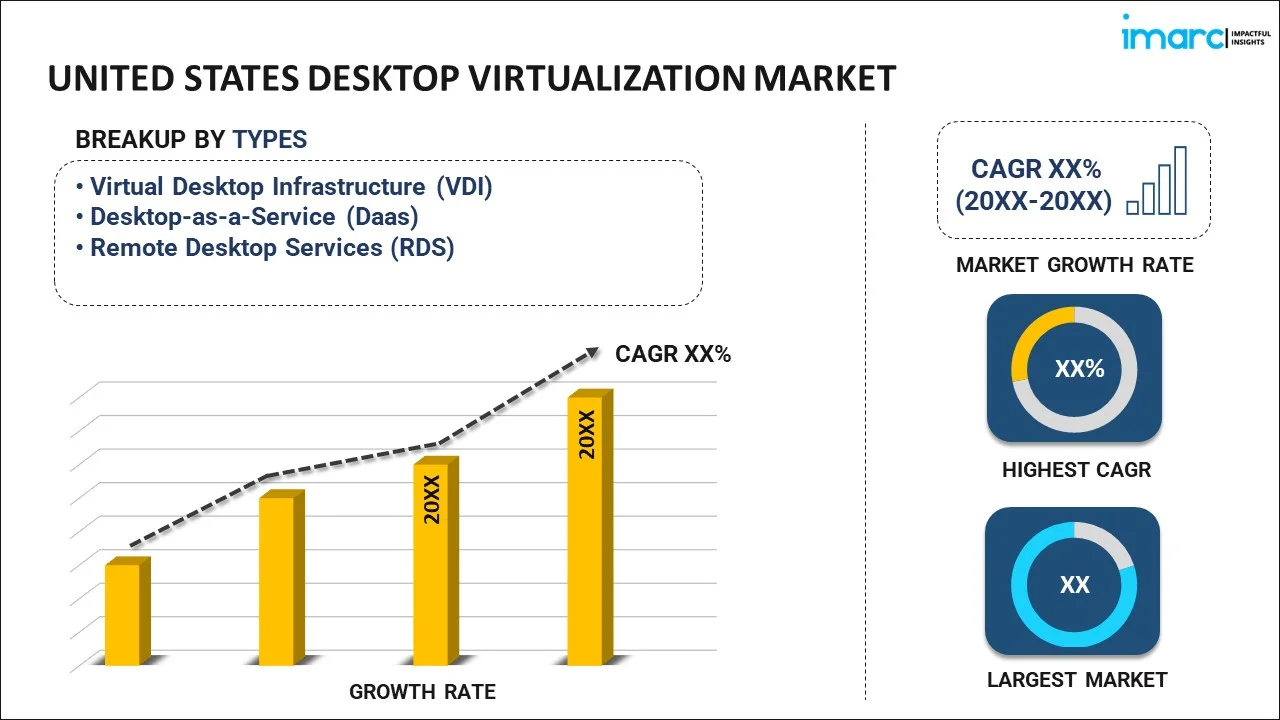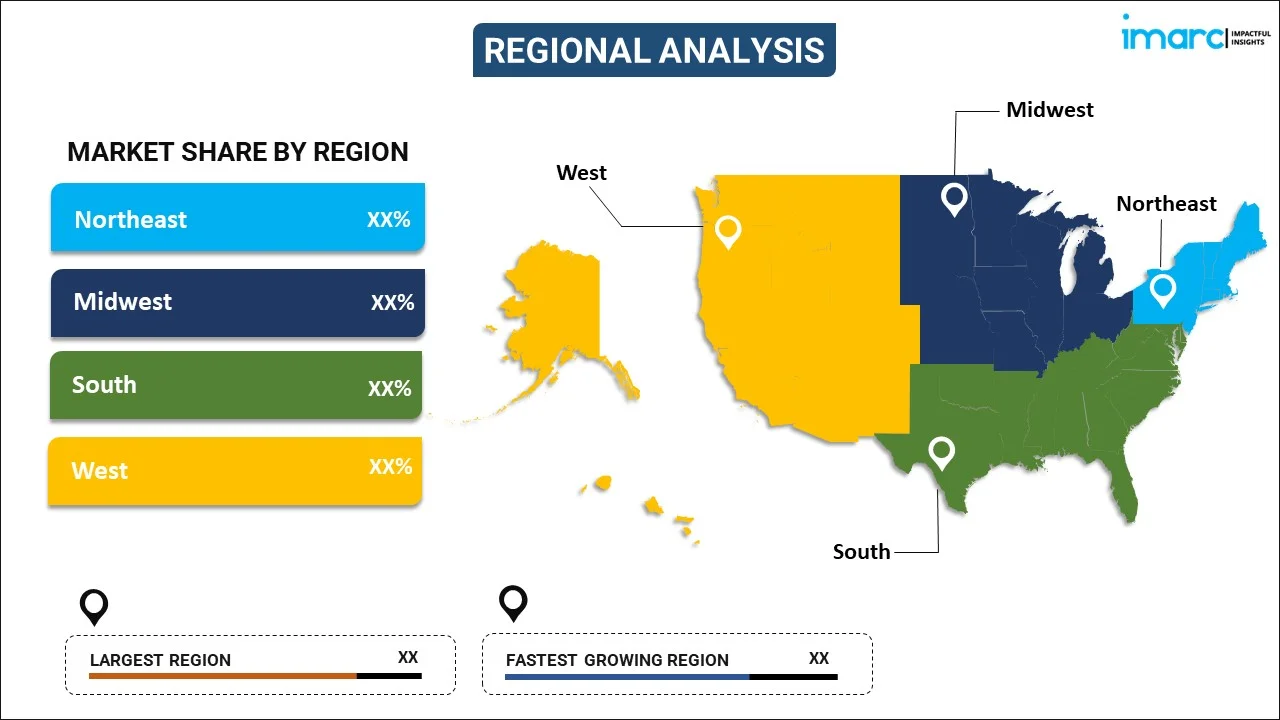
United States Desktop Virtualization Market Report by Type (Virtual Desktop Infrastructure (VDI), Desktop-as-a-Service (Daas), Remote Desktop Services (RDS)), Component (Software Solutions, Services), Organization Size (Small and Medium-sized Enterprises, Large Enterprises), Vertical (BFSI, IT and Telecom, Education, Healthcare, Government, Energy and Utilities, Manufacturing, and Others), and Region 2025-2033
Market Overview:
United States desktop virtualization market size reached USD 3.2 Billion in 2024. Looking forward, IMARC Group expects the market to reach USD 7.9 Billion by 2033, exhibiting a growth rate (CAGR) of 10.7% during 2025-2033. The rising need for offering efficiency, cost savings, and enhanced mobility among organizations seeking to optimize their IT infrastructures is primarily augmenting the market growth across the country.
|
Report Attribute
|
Key Statistics
|
|---|---|
|
Base Year
|
2024
|
|
Forecast Years
|
2025-2033
|
|
Historical Years
|
2019-2024
|
|
Market Size in 2024
|
USD 3.2 Billion |
|
Market Forecast in 2033
|
USD 7.9 Billion |
| Market Growth Rate 2025-2033 | 10.7% |
Desktop virtualization is a technology that enables the separation of a user's desktop environment from the physical device, allowing individuals to access their desktops and applications from virtually any device with an internet connection. Instead of relying on a specific physical computer, it centralizes the infrastructure, storing it on servers in data centers. This approach allows for a more flexible and scalable computing environment. Users can log in from various devices, including laptops, tablets, or thin clients, and experience a consistent desktop interface with access to their applications and data. One of the key advantages of desktop virtualization is the ability to streamline IT management and enhance security. IT administrators can centrally manage and update desktop images, ensuring consistency and simplifying maintenance tasks. Additionally, it provides improved data security as sensitive information is stored in the data center rather than on individual devices.
United States Desktop Virtualization Market Trends:
The United States desktop virtualization market is experiencing significant growth as organizations increasingly recognize the strategic benefits of this technology. The market in the U.S. is characterized by a growing demand for flexible and scalable computing solutions, with businesses leveraging desktop virtualization to enhance mobility and streamline IT management. This approach allows users to log in from various devices, promoting a consistent desktop experience across platforms. One of the driving factors behind the expanding market is the need for improved IT efficiency and security. Additionally, desktop virtualization aids in enabling centralized management, updates, and security protocols, which is positively influencing the regional market. Moreover, this not only simplifies IT administration but also enhances data security by storing sensitive information in a centralized, controlled environment. Besides this, as businesses prioritize agility, cost-effectiveness, and data protection, the United States desktop virtualization market is poised for continued growth, playing a pivotal role in reshaping how organizations manage their IT resources and support a mobile workforce over the forecasted period.
United States Desktop Virtualization Market Segmentation:
IMARC Group provides an analysis of the key trends in each segment of the market, along with forecasts at the country level for 2025-2033. Our report has categorized the market based on type, component, organization size, and vertical.
Type Insights:

- Virtual Desktop Infrastructure (VDI)
- Desktop-as-a-Service (Daas)
- Remote Desktop Services (RDS)
The report has provided a detailed breakup and analysis of the market based on the type. This includes virtual desktop infrastructure (VDI), desktop-as-a-service (Daas), and remote desktop services (RDS).
Component Insights:
- Software Solutions
- Services
A detailed breakup and analysis of the market based on component have also been provided in the report. This includes software solutions and services.
Organization Size Insights:
- Small and Medium-sized Enterprises
- Large Enterprises
The report has provided a detailed breakup and analysis of the market based on the organization size. This includes small and medium-sized enterprises and large enterprises.
Vertical Insights:
- BFSI
- IT and Telecom
- Education
- Healthcare
- Government
- Energy and Utilities
- Manufacturing
- Others
A detailed breakup and analysis of the market based on vertical have also been provided in the report. This includes BFSI, IT and telecom, education, healthcare, government, energy and utilities, manufacturing, and others.
Regional Insights:

- Northeast
- Midwest
- South
- West
The report has also provided a comprehensive analysis of all the major regional markets, which include the Northeast, Midwest, South, and West.
Competitive Landscape:
The market research report has also provided a comprehensive analysis of the competitive landscape in the market. Competitive analysis such as market structure, key player positioning, top winning strategies, competitive dashboard, and company evaluation quadrant has been covered in the report. Also, detailed profiles of all major companies have been provided.
United States Desktop Virtualization Market Report Coverage:
| Report Features | Details |
|---|---|
| Base Year of the Analysis | 2024 |
| Historical Period | 2019-2024 |
| Forecast Period | 2025-2033 |
| Units | Billion USD |
| Scope of the Report | Exploration of Historical and Forecast Trends, Industry Catalysts and Challenges, Segment-Wise Historical and Predictive Market Assessment:
|
| Types Covered | Virtual Desktop Infrastructure (VDI), Desktop-as-a-Service (Daas), Remote Desktop Services (RDS) |
| Components Covered | Software Solutions, Services |
| Organization Sizes Covered | Small and Medium-sized Enterprises, Large Enterprises |
| Verticals Covered | BFSI, IT and Telecom, Education, Healthcare, Government, Energy and Utilities, Manufacturing, Others |
| Regions Covered | Northeast, Midwest, South, West |
| Customization Scope | 10% Free Customization |
| Post-Sale Analyst Support | 10-12 Weeks |
| Delivery Format | PDF and Excel through Email (We can also provide the editable version of the report in PPT/Word format on special request) |
Key Questions Answered in This Report:
- How has the United States desktop virtualization market performed so far and how will it perform in the coming years?
- What has been the impact of COVID-19 on the United States desktop virtualization market?
- What is the breakup of the United States desktop virtualization market on the basis of type?
- What is the breakup of the United States desktop virtualization market on the basis of component?
- What is the breakup of the United States desktop virtualization market on the basis of organization size?
- What is the breakup of the United States desktop virtualization market on the basis of vertical?
- What are the various stages in the value chain of the United States desktop virtualization market?
- What are the key driving factors and challenges in the United States desktop virtualization?
- What is the structure of the United States desktop virtualization market and who are the key players?
- What is the degree of competition in the United States desktop virtualization market?
Key Benefits for Stakeholders:
- IMARC’s industry report offers a comprehensive quantitative analysis of various market segments, historical and current market trends, market forecasts, and dynamics of the United States desktop virtualization market from 2019-2033.
- The research report provides the latest information on the market drivers, challenges, and opportunities in the United States desktop virtualization market.
- Porter's five forces analysis assist stakeholders in assessing the impact of new entrants, competitive rivalry, supplier power, buyer power, and the threat of substitution. It helps stakeholders to analyze the level of competition within the United States desktop virtualization industry and its attractiveness.
- A competitive landscape allows stakeholders to understand their competitive environment and provides an insight into the current positions of key players in the market.
Need more help?
- Speak to our experienced analysts for insights on the current market scenarios.
- Include additional segments and countries to customize the report as per your requirement.
- Gain an unparalleled competitive advantage in your domain by understanding how to utilize the report and positively impacting your operations and revenue.
- For further assistance, please connect with our analysts.
 Request Customization
Request Customization
 Speak to an Analyst
Speak to an Analyst
 Request Brochure
Request Brochure
 Inquire Before Buying
Inquire Before Buying




.webp)




.webp)












